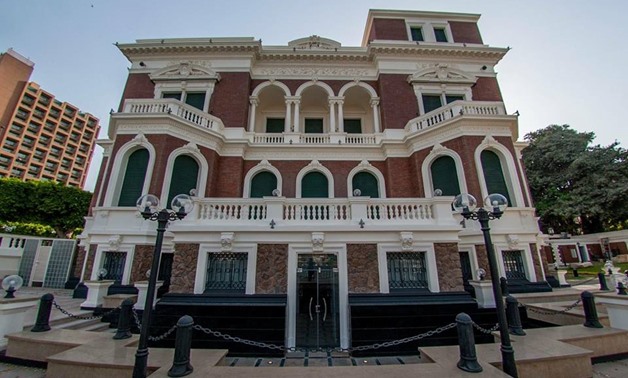
Aeisha Fahmy Palace in Zamalek – Hossam Manadily for the Cultural Development Fund
CAIRO – 17 May 2017: A visual art exhibition of 80 Egyptian and international works of art held at the recently renovated, 110-year old Aeisha Fahmy Palace will stay open to the public until mid-August.
 A chamber in the palace – Hossam Manadily
A chamber in the palace – Hossam Manadily
The exhibition, entitled “treasures from our museums,” will be open in Ramadan from 9 a.m. until 2 p.m., and again from 8 p.m. until 10 p.m.
 A staircase at the palace – Hossam Manadily
A staircase at the palace – Hossam Manadily
The Aiesha Fahmy Palace, designed by Italian architect Antonio Lashak in 1907, was inaugurated 17 May after renovation works that began in 2005 at a cost of LE 26 million.
 A painted room at the palace – Hossam Manadily
A painted room at the palace – Hossam Manadily
The 600-m2 palace includes galleries that showcase the works of young painters, a Japanese chamber, and an antique bathroom. It also displays works by renowned Egyptian sculptor Mahmoud Mokhtar and other pieces of art that date back to the 18th and 19th centuries.
 One of the palace’s rooms after renovation – Hossam Manadily
One of the palace’s rooms after renovation – Hossam Manadily
The palace, built over a 2,780-m2 piece of land that overlooks the Nile in Cairo’s upscale Zamalek, is an important architectural piece of art in the capital, in addition to valuable paintings on its walls, including ones that bear silk and linen, said Culture Minister Helmy al-Nemnem during the opening.
 Stained glass at the palace – Hossam Manadily
Stained glass at the palace – Hossam Manadily
Other paintings showcase aspects of life in Egypt that have almost vanished, such as paintings about the countryside with waterwheels and shadoof (swape), and ones that depict the relationship between farmers and animals, according to Nemnem.
 A hallway at the palace – Hossam Manadily
A hallway at the palace – Hossam Manadily
The minister emphasized that any venue for art or culture “counters terrorism and extremism,” and that the Aeisha Fahmy Palace redresses the critical idea of sculpture among Islamists, as it hosts several sculptures.
The palace was owned by Aeisha, daughter of Ali Pasha Fahmy, a senior official in the government of King of Egypt Fuad I.
It was nationalized in 1958 amid a wave of crackdown on the assets of the upper class, and was decreed to be a presidential palace, and another decree in 1964 ordered it be seized for public benefit. In February 1973, a third presidential decree decided it becomes a museum for the jewelry of the family of Mohamed Ali Pasha.
Although none of the decrees were applied, the Culture Ministry has been the official owner of the palace since 1973. The heirs of Aeisha Fahmy, who died in 1962, were compensated with LE 71.3 million per a court ruling in 2007.
 A hallway with a closed balcony at the palace – Hossam Manadily
A hallway with a closed balcony at the palace – Hossam Manadily







Comments
Leave a Comment